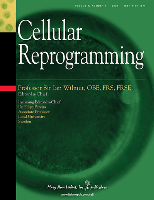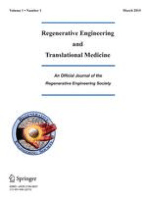
Cellular Reprogramming
Scope & Guideline
Advancing the Future of Cellular Therapies
Introduction
Aims and Scopes
- Cellular Reprogramming Techniques:
The journal covers various methodologies for inducing cellular reprogramming, including the use of transcription factors, small molecules, and gene editing technologies like CRISPR/Cas9. - Stem Cell Biology:
Research on different types of stem cells, including induced pluripotent stem cells (iPSCs) and mesenchymal stem cells, is a core focus, particularly their differentiation potential and applications in regenerative medicine. - Therapeutic Applications:
The journal emphasizes the clinical potential of cellular reprogramming in treating diseases, including cancer, neurodegenerative disorders, and age-related conditions. - Ethical Considerations:
Exploration of the ethical implications surrounding cellular reprogramming and stem cell research, ensuring responsible advancement in the field. - Interdisciplinary Collaborations:
The journal features interviews and discussions with leading researchers, fostering interdisciplinary collaboration across fields such as developmental biology, genetics, and regenerative medicine.
Trending and Emerging
- Aging and Cellular Rejuvenation:
There is a growing focus on the role of cellular reprogramming in reversing age-related changes and rejuvenating aged tissues, underlining its potential in regenerative medicine. - Gene Therapy and Editing Technologies:
Recent articles highlight the integration of gene therapy and advanced editing technologies, such as base editing and CRISPR, as critical components in enhancing reprogramming efficiency and safety. - Exosome and Extracellular Vesicle Research:
Emerging studies on the roles of exosomes and extracellular vesicles derived from stem cells are gaining traction, suggesting their potential in cell communication and regeneration. - Applications in Cancer Therapy:
The application of cellular reprogramming techniques in cancer therapy is increasingly discussed, particularly how reprogrammed cells can be utilized for targeted treatments. - Ethics and Public Policy:
There is an emerging discourse around the ethical implications and regulatory frameworks of cellular reprogramming, reflecting a growing awareness of the societal impacts of this research.
Declining or Waning
- Traditional Cloning Techniques:
Earlier articles emphasized cloning methodologies, but recent trends show a shift towards innovative reprogramming methods, indicating that traditional cloning may be waning in favor of more advanced techniques. - Basic Mechanistic Studies:
While foundational mechanistic studies were prevalent in earlier publications, there is a noticeable decline in purely theoretical discussions as the journal increasingly prioritizes practical applications and therapeutic advancements. - Limited Focus on Non-Mammalian Systems:
Research involving non-mammalian model organisms has decreased, with a stronger emphasis now on mammalian systems and human applications, suggesting a narrowing of the scope towards clinically relevant studies.
Similar Journals

IN VITRO CELLULAR & DEVELOPMENTAL BIOLOGY-ANIMAL
Illuminating the Path of In Vitro StudiesIN VITRO CELLULAR & DEVELOPMENTAL BIOLOGY-ANIMAL, published by SPRINGER, is a pivotal journal in the fields of cell biology and developmental biology, focusing on in vitro studies that enhance our understanding of animal cellular mechanisms and development. With an ISSN of 1071-2690 and an E-ISSN of 1543-706X, this esteemed journal offers a platform for researchers to present their findings and contribute to the body of knowledge necessary for advancements in biological sciences. As a recognized publication, it holds a 2023 category quartile of Q4 in Cell Biology and Developmental Biology, and Q3 in miscellaneous Medicine, reflecting its competitive position yet inviting critical submissions that can span multidisciplinary approaches. Though currently not open access, it serves as an essential resource for professionals, researchers, and students dedicated to unraveling the complexities of cellular processes in an ever-evolving field. The journal has been continuously published since 1986, signifying its long-standing commitment to fostering scientific discourse and innovation.

Stem Cell Research
Fostering collaboration in stem cell research.Stem Cell Research is a premier Open Access journal published by ELSEVIER, dedicated to advancing the understanding of stem cell biology. Since its inception in 2007, the journal has provided a platform for the latest research in the fields of Cell Biology, Developmental Biology, and Medicine, with its publication being accessible globally since 2014. Located in the Netherlands, the journal’s comprehensive scope aims to bridge fundamental discoveries with clinical applications, fostering collaboration among researchers and professionals. With a 2023 impact factor reflected in its Q4 ranking in Cell and Developmental Biology and a commendable position in the 64th percentile for General Medicine, Stem Cell Research remains a vital resource for those interested in the dynamic landscape of regenerative medicine. Targeting an audience that includes researchers, practitioners, and students, the journal emphasizes not only the significance of stem cells in medical science but also the ethical considerations and the public discourse surrounding stem cell research. Join the community committed to pioneering the future of stem cell science through rigorous peer-reviewed research.

Stem Cells Translational Medicine
Empowering Researchers in the Stem Cell RevolutionStem Cells Translational Medicine, published by Oxford University Press, is a leading open-access journal that has been at the forefront of stem cell research since its launch in 2012. With an impressive impact across various categories, it occupies Q2 in Cell Biology and is highly recognized in Q1 for both Developmental Biology and Miscellaneous Medicine in 2023. Its strong Scopus rankings highlight its significance in the fields of Biochemistry, Genetics, and Molecular Biology, achieving an outstanding percentile ranking of 93rd in Developmental Biology. The journal provides a pivotal platform for researchers, professionals, and students to publish and access cutting-edge findings that contribute to the understanding and application of stem cell technology. With a commitment to disseminating high-quality scientific knowledge, Stem Cells Translational Medicine plays a vital role in advancing research and innovation within the rapidly evolving landscape of regenerative medicine.

Stem Cells International
Advancing the Frontiers of Stem Cell ResearchStem Cells International is a premier open access journal published by HINDAWI LTD, focusing on the rapidly evolving field of stem cell research. With an ISSN of 1687-966X and E-ISSN 1687-9678, this journal has been a vital resource since its inception in 2010, showcasing innovative studies and breakthroughs up to 2024. Positioned in Q3 in Cell Biology and Q2 in Molecular Biology for 2023, as well as well-ranked in the Scopus database, the journal serves as an essential platform for researchers, professionals, and students dedicated to exploring the implications of stem cell technology in regenerative medicine and biological research. The open access model ensures wide accessibility, fostering collaboration and knowledge-sharing across the scientific community, making it a cornerstone in advancing the understanding and application of stem cell science.

CELL AND TISSUE BANKING
Fostering knowledge transfer in cutting-edge biomedical fields.CELL AND TISSUE BANKING, published by Springer, is a prominent journal dedicated to advancing the fields of biomaterials, biomedical engineering, cell biology, and transplantation. With its ISSN 1389-9333 and E-ISSN 1573-6814, the journal plays a crucial role in disseminating high-quality research from its inception in 2000 to its ongoing contributions through 2024. Situated in the Netherlands, it boasts a respectable 2023 impact factor with notable quartile rankings, positioning it within the Q3 category for biomaterials, biomedical engineering, and transplantation, and Q4 for cell biology. Furthermore, its Scopus rankings underscore its relevance and influence, particularly in the fields of medicine and engineering. Although it does not currently offer open access options, the journal remains a vital resource for researchers, professionals, and students alike, fostering innovation and knowledge transfer in the critical areas of cell and tissue sustainability.

CYTOTHERAPY
Pioneering Innovations in Regenerative Medicine.CYTOTHERAPY is a distinguished journal published by Elsevier Science Ltd, focusing on the critical fields of cell therapy, transplantation, and regenerative medicine. Since its inception in 1999, the journal has established itself as a vital resource for researchers and practitioners, contributing significantly to advancements in Cancer Research, Cell Biology, Genetics, Immunology, and Oncology. With an impressive range of Q2 rankings across multiple categories and a remarkable Q1 standing in Transplantation for 2023, CYTOTHERAPY delivers high-impact research that addresses the evolving challenges in these fields. While the journal does not offer open access, it remains a reputable avenue for disseminating pivotal studies and reviews that push the boundaries of cell-based therapies. Researchers, clinicians, and students alike will find CYTOTHERAPY an indispensable platform to stay abreast of the latest discoveries and innovations that are shaping the future of medical science.

Current Stem Cell Reports
Elevating Research Standards in Stem Cell ApplicationsCurrent Stem Cell Reports, published by Springer Heidelberg, is an esteemed academic journal that has emerged as a pivotal resource in the fields of Cell Biology, Developmental Biology, Genetics, and Molecular Biology. Since its inception in 2015, this journal has consistently contributed to the evolving discourse on stem cell research and its applications, providing a platform for innovative studies and reviews through 2024. With a notable impact indicated by its quartile rankings—Q2 in Developmental Biology and Genetics, and Q3 in Cell Biology and Molecular Biology—it engages a diverse audience of researchers, professionals, and students who seek high-quality, accessible research insights. Although offering a traditional access model, the content remains vital for those invested in understanding the implications of stem cell advancements. Located in Switzerland and operating from the heart of Heidelberg, this journal aspires to bridge gaps in knowledge and stimulate collaboration in the burgeoning field of stem cell science.

Regenerative Therapy
Pioneering research in regenerative therapy for a healthier tomorrow.Regenerative Therapy is a premier open-access journal dedicated to advancing the fields of biomaterials, biomedical engineering, and developmental biology. Published by Elsevier in Japan, this journal has been an influential platform since its inception in 2015, contributing significantly to the global discourse on regenerative medicine. With an impressive Q2 ranking in major categories such as Biomaterials and Biomedical Engineering, it is recognized for its quality of research and innovation. Researchers seeking to disseminate their findings or explore cutting-edge developments will find Regenerative Therapy to be invaluable, reflecting current trends and fostering collaborations across interdisciplinary boundaries. The journal offers open access, ensuring that high-quality research is available to a broad audience and enhances the impact of scholarly work in the regenerative medicine community.

American Journal of Stem Cells
Innovative insights shaping the future of biochemistry and genetics.American Journal of Stem Cells is a leading multidisciplinary publication dedicated to advancing the field of regenerative medicine and stem cell research. Published by E-CENTURY PUBLISHING CORP, this journal has gained recognition for its commitment to high-quality scientific contributions, achieving impressive rankings within the Scopus database, particularly in the areas of Biochemistry, Genetics and Molecular Biology, and Developmental Biology. With its focus on innovative research, the journal offers crucial insights and developments that appeal to researchers, professionals, and students alike. Although it is not an open-access journal, the American Journal of Stem Cells plays a pivotal role in disseminating impactful findings that define the future of cellular therapies and regenerative methodologies. The journal's past coverage from 2012 to 2017 reflects its dedication to advancing knowledge in key scientific disciplines, making it an essential resource for anyone engaged in the dynamic landscape of stem cell science.

Regenerative Engineering and Translational Medicine
Pioneering Insights in Regenerative HealthRegenerative Engineering and Translational Medicine is an esteemed academic journal published by Springer Heidelberg, focusing on the interdisciplinary fields of biomaterials, biomedical engineering, and cell biology. With an ISSN of 2364-4133 and an E-ISSN of 2364-4141, the journal has carved a niche for itself since its inception in 2015, showcasing cutting-edge research that bridges the gap between scientific findings and practical applications in regenerative medicine. As a recognized platform in its field, it is currently positioned within Q3 quartiles in biomaterials, biomedical engineering, and medicine (miscellaneous), with a Scopus ranking that reflects its growing influence among peers. The journal aims to disseminate high-quality, peer-reviewed articles that highlight advancements in regenerative engineering, further advancing both theoretical and applied research. Scholars and practitioners seeking to stay at the forefront of the ever-evolving landscape of regenerative health solutions will find invaluable insights and innovations within these pages. Join a community of leading thinkers and explore the journal's comprehensive research contributions, which are crucial for fostering partnerships between academia and industry in the quest for transformative medical solutions.